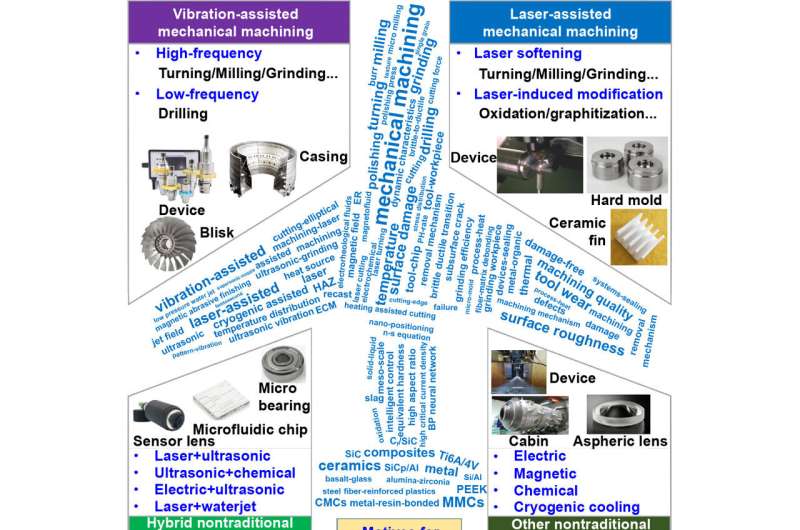This article has been reviewed according to Science X's editorial process and policies. Editors have highlighted the following attributes while ensuring the content's credibility:
fact-checked
proofread
How to make difficult-to-cut materials and components 'easy-to-cut'

Difficult-to-cut materials such as titanium alloys, high-temperature alloys, metal/ceramic/polymer-matrix composites, hard and brittle materials, as well as geometrically complex components such as thin-walled structures, micro channels and complex surfaces, are widely used in aerospace community.
Nevertheless, many problems including severe and rapid tool wear, low machining efficiency, and poor surface integrity exist in mechanical machining. How to efficiently and precisely process these materials and components, i.e., make difficult-to-cut into "easy-to-cut," addresses increasing attention.
Published in International Journal of Extreme Manufacturing, Prof. Wenfeng Ding and coworkers from Nanjing University of Aeronautics and Astronautics comprehensively introduced nontraditional energy-assisted mechanical machining, a promising technology for aerospace engineering.
This review gives readers a glimpse of how these hybrid processes break the cognition of processing efficiency and quality cannot be achieved simultaneously. It also gives readers a deep understanding of how the innovative hybrid method will affect the manufacturing of aerospace equipment and the development of the aerospace community.
It discusses the processing principles, material responses under nontraditional energy, resultant forces and temperatures, material removal mechanisms and applications of these hybrid processes. In addition, it addresses a comprehensive summary of both the advantages and limitations of each hybrid process as well as future perspectives on forward design, device development and sustainability.
Nontraditional energy-assisted mechanical machining is a hybrid process using nontraditional energies (vibration, laser, electricity, etc.) to improve the machinability of local materials and decrease the burden of mechanical machining. In this process, mechanical machining is the main technique for material removal, which is assisted by nontraditional energies having significant positive effects on the material removal process.
This technology provides a feasible and promising way to improve material removal rate and surface quality, reducing process forces, and prolonging tool life in processing the difficult-to-cut materials and components in aerospace community.
The transformation from difficult-to-cut to "easy-to-cut" is achieved by using nontraditional energy to change the tool-workpiece contact condition as in vibration-assisted machining, soften or modify the local material as in laser-assisted machining, control the tool kinematics as in magnetic and chemical-assisted machining, and upgrade the process condition as in advanced coolant-assisted machining.
Optimal outcomes can be achieved by means of applying appropriate nontraditional energy to assist mechanical machining while considering the characteristics of both the material and the energy.
"For example, we proposed a novel hybrid process of laser-induced oxidation-assisted mechanical machining in which a pulsed laser is utilized to induce an oxidation reaction between the irradiated workpiece material and oxygen. This resulted in the formation of loose and porous oxides, which could be easily removed with the cutting tool," said Prof. Guolong Zhao.
"However, not all the materials can be processed with this method, for example, some oxide ceramics which cannot be further oxidized, and glasses which have very low absorption rate of laser."
Despite of remarkable progress in nontraditional energy-assisted mechanical machining technology, some specific challenges remain unaddressed.
Prof. Guolong Zhao, the first author said, "There is still a significant challenge promoting the wide application of this technology in the aerospace community. For example, it is still difficult currently to apply laser-assisted mechanical machining to process geometrically complex structures. Collaborative cooperation between the laser scanning and cutting tool movement should be taken into consideration."
"For vibration-assisted mechanical machining, it is crucial to enhance the performance of vibration processing equipment, and provide innovative tools compatible with ultrasonic vibrations," said Dr. Biao Zhao.
To overcome these issues, the most effective and innovative way is to conduct process forward design and develop intelligent equipment.
Prof. Wenfeng Ding, the corresponding author said, "The term 'hybrid' here is not just a simple combination of nontraditional energy with mechanical machining, forward design is mandatory in order to achieve an optimal match between the technology and processing demands in terms of efficiency, quality and cost. Besides, the development of intelligent equipment for nontraditional energy-assisted mechanical machining is mandatory in order to promote wide application of these technologies."
With the rapid development of the aerospace community, more and more difficult-to-cut materials and components with excellent comprehensive properties and the ability to operate under extremely harsh environments, are being invented and utilized.
"It is still a long way to go for this hybrid method from laboratory to factory," said Prof. Ding.
"Future works on fundamental research, technical breakthrough and equipment development are required. It is a leading crossing discipline which covers many fields such as mechanics, physics, chemistry and material science. Wide-ranging interdisciplinary collaborations are necessary to promote the wide application of nontraditional energy-assisted mechanical machining technology in the aerospace community."
More information: Guolong Zhao et al, Nontraditional energy-assisted mechanical machining of difficult-to-cut materials and components in aerospace community: a comparative analysis, International Journal of Extreme Manufacturing (2023). DOI: 10.1088/2631-7990/ad16d6




















